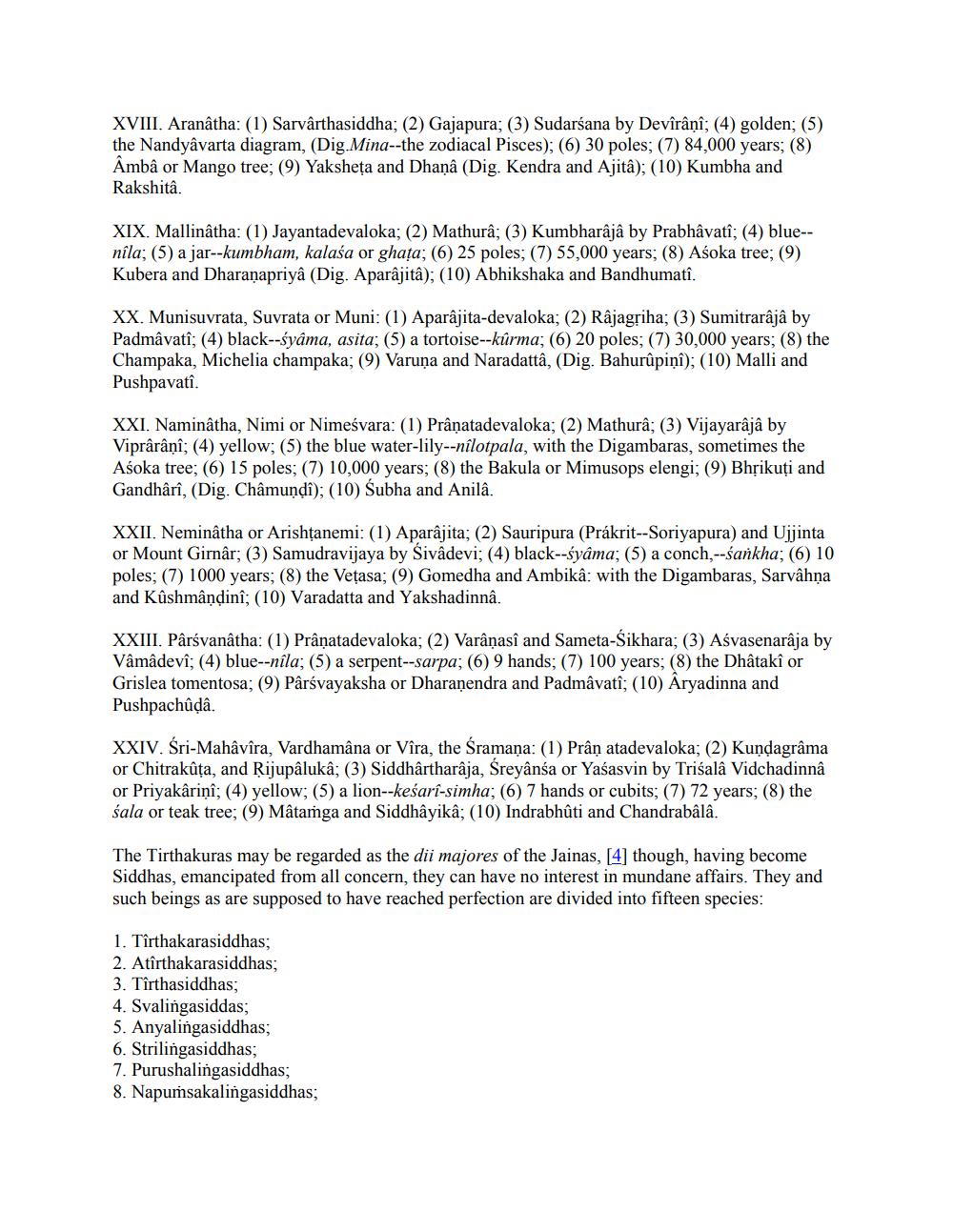________________
XVIII. Aranatha: (1) Sarvârthasiddha; (2) Gajapura; (3) Sudarsana by Devîrânî; (4) golden; (5) the Nandyavarta diagram, (Dig. Mina--the zodiacal Pisces); (6) 30 poles; (7) 84,000 years; (8) Âmbâ or Mango tree; (9) Yaksheta and Dhana (Dig. Kendra and Ajitâ); (10) Kumbha and Rakshita.
XIX. Mallinâtha: (1) Jayantadevaloka; (2) Mathurâ; (3) Kumbharâjâ by Prabhâvatî; (4) blue-- nila; (5) a jar--kumbham, kalasa or ghața; (6) 25 poles; (7) 55,000 years; (8) Asoka tree; (9) Kubera and Dharanapriya (Dig. Aparajita); (10) Abhikshaka and Bandhumatî.
XX. Munisuvrata, Suvrata or Muni: (1) Aparajita-devaloka; (2) Rajagriha; (3) Sumitrarâjâ by Padmavatî; (4) black--syâma, asita; (5) a tortoise--kúrma; (6) 20 poles; (7) 30,000 years; (8) the Champaka, Michelia champaka; (9) Varuņa and Naradattâ, (Dig. Bahurûpiņi); (10) Malli and Pushpavati.
XXI. Naminâtha, Nimi or Nimeśvara: (1) Prânatadevaloka; (2) Mathurâ; (3) Vijayarâjâ by Viprârâņî; (4) yellow; (5) the blue water-lily--nilotpala, with the Digambaras, sometimes the Asoka tree; (6) 15 poles; (7) 10,000 years; (8) the Bakula or Mimusops elengi; (9) Bhrikuti and Gandhârî, (Dig. Châmundi); (10) Subha and Anilâ.
XXII. Neminâtha or Arishțanemi: (1) Aparajita; (2) Sauripura (Prakrit--Soriyapura) and Ujjinta or Mount Girnar; (3) Samudravijaya by Sivadevi; (4) black--syâma; (5) a conch,--sankha; (6) 10 poles; (7) 1000 years; (8) the Vețasa; (9) Gomedha and Ambika: with the Digambaras, Sarvâhņa and Kûshmândinî; (10) Varadatta and Yakshadinnâ.
XXIII. Pârsvanatha: (1) Prânatadevaloka; (2) Varâņasî and Sameta-Sikhara; (3) Aśvasenarâja by Vâmâdevî; (4) blue--nila; (5) a serpent--sarpa; (6) 9 hands; (7) 100 years; (8) the Dhâtakî or Grislea tomentosa; (9) Pârsvayaksha or Dharanendra and Padmâvatî; (10) Aryadinna and Pushpachada.
XXIV. Sri-Mahâvîra, Vardhamâna or Vîra, the Sramaņa: (1) Prâņ atadevaloka; (2) Kundagrâma or Chitrakûța, and Rijupâlukâ; (3) Siddhartharâja, Sreyânsa or Yaśasvin by Trisala Vidchadinna or Priyakâriņî; (4) yellow; (5) a lion--keśarí-simha; (6) 7 hands or cubits; (7) 72 years; (8) the sala or teak tree; (9) Mâtamga and Siddhâyikâ; (10) Indrabhûti and Chandrabâlâ.
The Tirthakuras may be regarded as the dii majores of the Jainas, [4] though, having become Siddhas, emancipated from all concern, they can have no interest in mundane affairs. They and such beings as are supposed to have reached perfection are divided into fifteen species:
1. Tîrthakarasiddhas, 2. Atîrthakarasiddhas, 3. Tîrthasiddhas; 4. Svalingasiddas; 5. Anyalingasiddhas; 6. Strilingasiddhas; 7. Purushalingasiddhas; 8. Napumsakalingasiddhas;




